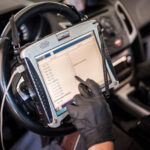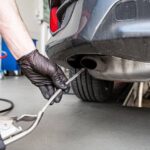Slide 1. Introduction.
The class develops the symptoms of a clogged particulate filter, solutions, and implications for fleet management.
Slide 2. Clogged particulate filter.
- Why does the particulate filter become clogged?.
The particulate filter-DPF is an essential component in diesel engines and, in some cases, in latest-generation gasoline engines. Its main function is to trap soot and impurities generated by combustion in order to reduce pollutant emissions. However, with continued use, saturation and a decrease in efficiency may occur. It is crucial to identify the symptoms of a clogged particulate filter in a timely manner to maintain optimal engine performance and avoid costly repairs.
The particulate filter is an essential component of the exhaust system, playing a crucial role in trapping polluting particles. Urban driving, short trips, and frequent starts prevent it from reaching the temperature necessary for regeneration, causing soot to accumulate. This situation is what causes most problems.
A collapsed particulate filter significantly affects the vehicle's performance and its compliance with environmental regulations.
Timely detection of the symptoms of a clogged particulate filter can prevent costly breakdowns, engine failures, and problems at the MOT.
- Symptoms of a clogged particulate filter.
These are the most common signs that the filter needs attention.
- Loss of power.
The engine performs poorly, with difficulty climbing hills and forced driving.
- Increased fuel consumption.
The engine requires a greater supply of fuel to compensate for the decrease in flow in the exhaust system.
- Warning light.
A warning light appears on the dashboard to alert you to abnormal pressure in the system.
- Difficult starting and unstable idling.
Vibrations and noises when the car is idling.
- Excessive smoke in the exhaust.
Dark gases due to incomplete combustion, especially in diesel engines.
- How particle filter regeneration works.
Soot particles accumulate in the particulate filter. When the sensors detect that the filter is 40% saturated, the vehicle itself increases the engine temperature to force the particulate filter to regenerate. When a temperature of 700ºC is reached, the soot burns and is released into the atmosphere in a more purified form.
This process can be carried out automatically while driving, provided that high temperatures are reached in the exhaust system and long distances are traveled.
During the process, you may notice an increase in idle speed and temperature. Occasionally, a notification may be activated on the dashboard. It is important to note that repeatedly interrupting the regeneration process is considered one of the main causes of blockage.
- Consequences of driving with a clogged filter.
Driving with a clogged filter not only reduces engine efficiency, but can also cause major damage.
- Turbo problems.
- EGR valve failures.
- Engine overheating.
- Failure of the MOT test due to excessive emissions.
- Complete replacement of the filter, which can cost over 1,000 euros.
- How to extend the life of the particulate filter.
Adopting good driving and maintenance habits prevents premature clogging.
- Avoid short trips and opt for long journeys to facilitate regeneration.
- Accelerate smoothly while maintaining an appropriate speed.
- Use quality fuel and check the oil and coolant regularly.
- Have forced regeneration carried out at a workshop if the symptoms persist.
- When should the particulate filter be replaced or cleaned?.
The particulate filter can be cleaned, which is more economical than replacing it. There are workshops that specialize in cleaning particulate filters.
Replacing the particulate filter is the final measure to be taken when all options for regeneration and cleaning have been exhausted. Generally, it is necessary to replace the filter after 150,000 kilometers, although this may vary depending on use and previous care.
If the warning light remains on and the vehicle continues to malfunction after regeneration, it is imperative that a specialist confirm whether replacement or cleaning is necessary.
- Ways to clean a particulate filter.
- Take to the road and perform the regeneration yourself.
The system regenerates automatically approximately every 1,000 kilometers. You will notice this when the idle speed changes from 900 rpm to 1,500 rpm. If this is not sufficient, you should get on the road and drive for about 20 minutes with the engine revving between 2,000 rpm and 2,500 rpm.
- Add chemical additives to the fuel tank.
It is possible to add a product designed to clean the particulate filter, for both gasoline and diesel engines. These additives raise the temperature of the exhaust pipe to facilitate the dissolution of dirt accumulated in the filter. The price of this product ranges from 15 to 30 euros.
- The diagnostic machine can clean the filter.
Through heat treatment, the diagnostic machine controls all vehicle parameters involved in particle filter regeneration. If the engine is cold, it will start by running it at 2,000 rpm until it reaches the optimum operating temperature. In such cases, the system increases the engine speed to generate heat for as long as necessary until the system determines that the filter has been unclogged. It is not necessary to remove the filter, and the approximate cost is 50 euros.
- Ultrasonic cleaning.
In this case, it is necessary to go to a specialized workshop to remove the filter in question. The ultrasonic machine works by vibrating the filter itself to clean its components, and the results are quite good. The process takes approximately one hour and the estimated cost is 100 euros.
- Soak the particle filter in detergent.
This alternative should be considered as a last resort. It is strongly recommended to use this method when the diagnostic machine is unable to clean the filter. This occurs when the filter saturation reaches 96% or more. In this case, it will be necessary to remove the filter and soak it in detergent for one hour. It should then be washed with pressurized water and finally dried thoroughly before being reinstalled in the vehicle. The cost of this process can be around 150 euros.
- Implications for fleet management.
The main consequence is the cost of cleaning or replacing the particulate filter, in addition to the time the vehicle is out of service.
A clogged particulate filter increases pollutant emissions and the vehicle will not pass the MOT.
The particulate filter must be cleaned in a specialized workshop by qualified personnel.
If the particulate filter is replaced, a new one must be installed; it is not recommended to use another used particulate filter.
It is not recommended to bypass the particulate filter, because pollutant emissions will increase considerably and the vehicle will not pass the MOT test.
During preventive maintenance, a diagnosis must be performed via the OBD port to check for fault codes related to the particulate filter, especially the pressure sensor.
The differential pressure sensor measures the pressure difference between the inlet and outlet of the particulate filter. This pressure difference is directly related to the amount of particles in the filter. If the differential pressure is excessively high, this could indicate a blockage in the particulate filter, which would require regeneration, replacement, or cleaning.
The differential pressure sensor is an essential component for ensuring the efficient and reliable operation of the particulate filter. Sensor failure can lead to problems such as unnecessary regeneration or insufficient regeneration, which can damage the particulate filter or affect engine performance. It is imperative to replace the differential pressure sensor when it is defective or reaches the end of its recommended service life in order to ensure safe and efficient operation of the particulate filter.
In summary, the particulate filter is an essential component for complying with emissions regulations and ensuring engine efficiency. Timely detection of the symptoms of a clogged particulate filter and immediate action are critical to avoiding costly repairs and improving vehicle durability.
Slide 3. Thank you for your time.
The class has developed the symptoms of a clogged particulate filter, the solutions, and the implications for fleet management, see you soon.
Download the audio




















